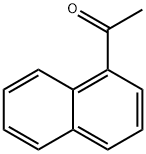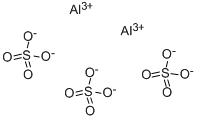Aluminum , 99% , 7429-90-5
Synonym(s):
Aluminum;aluminum foil;Aluminium;tube foil;tube sealing foil
CAS NO.:7429-90-5
Empirical Formula: Al
Molecular Weight: 26.98
MDL number: MFCD00134029
EINECS: 231-072-3
PRODUCT Properties
| Melting point: | 660.37 °C (lit.) |
| Boiling point: | 2460 °C (lit.) |
| Density | 2.7 g/mL at 25 °C (lit.) |
| bulk density | 0.77g/cm3 |
| vapor pressure | 0.13-1300Pa at 974℃ |
| Flash point: | 400°C |
| storage temp. | Flammables area |
| solubility | insoluble in H2O; soluble in acid solutions, alkaline solutions |
| form | wire |
| Specific Gravity | 2.702 (Water=1) |
| color | Yellow |
| PH | 0.5 (H2O, 20°C) |
| Odor | Odorless |
| Flame Color | Silvery-white |
| biological source | goat |
| Resistivity | 2.6548 μΩ-cm |
| Water Solubility | Insoluble in water. |
| Sensitive | Moisture Sensitive |
| Merck | 13,321 / 13,321 |
| Exposure limits | TLV-TWA 10 mg/m3 (Al dust), 5 mg/m3
(pyrophoric Al powder and welding fumes),
2 mg/m3 (soluble Al salts and alkyls)
(ACGIH). |
| Dielectric constant | 1.6-1.8(0.0℃) |
| Stability: | Stable. Powder is flammable. Reacts very exothermically with halogens. Moisture and air sensitive. Incompatible with strong acids, caustics, strong oxidizing agents, halogenated hydrocarbons. |
| CAS DataBase Reference | 7429-90-5(CAS DataBase Reference) |
| NIST Chemistry Reference | Aluminum(7429-90-5) |
| EPA Substance Registry System | Aluminum (7429-90-5) |
Description and Uses
Although aluminum was one of the last metals to be commercialized, it has been recognized for centuries. Aluminum was first recognized by the Romans as an astringent substance, and they called it ‘alum.’ By the middle ages it was manufactured as ‘alum stone,’ a subsulfate of alumina and potash. In 1825, Hans C. ?ersted was able to isolate a few drops of the raw material, and by 1886 it had patents from both Charles Martin Hall of the United States and Paul-Louis-Toussaint Heroult of France. Aluminum was commercialized in industry by the end of the nineteenth century.
Aluminum is a very versatile metal with many uses in today’s economy, the most common ofwhich are in construction, in the aviation-space industries, and in the home and automobile industries.Its natural softness is overcome by alloying it with small amounts of copper or magnesium thatgreatly increase its strength. It is used to make cans for food and drinks, in pyrotechnics, for protectivecoatings, to resist corrosion, to manufacture die-cast auto engine blocks and parts, for homecooking utensils and foil, for incendiary bombs, and for all types of alloys with other metals.
Aluminum does not conduct electricity as well as copper, but because it is much lighter inweight, it is used for transmission lines, though not in household wiring. A thin coating ofaluminum is spread on glass to make noncorroding mirrors. Pure oxide crystals of aluminumare known as corundum, which is a hard, white crystal and one of the hardest substancesknown. Corundum finds many uses in industry as an abrasive for sandpaper and grindingwheels. This material also resists heat and is used for lining high-temperature ovens, to formthe white insulating part of spark plugs, and to form a protective coating on many electronicdevices such a transistors.Aluminum oxide is used to make synthetic rubies and sapphires for lasers beams. It hasmany pharmaceutical uses, including ointments, toothpaste, deodorants, and shaving creams.
Safety
| Symbol(GHS) |  GHS02 |
| Signal word | Danger |
| Hazard statements | H228-H261 |
| Precautionary statements | P210-P223-P231+P232-P240-P241-P280 |
| Hazard Codes | F,Xi,Xn,N |
| Risk Statements | 17-15-36/38-10-67-65-62-51/53-48/20-38-11-50 |
| Safety Statements | 7/8-43A-43-26-62-61-36/37-33-29-16-9 |
| RIDADR | 1396 |
| OEB | B |
| OEL | TWA: 10 mg/m3 (total) |
| WGK Germany | 3 |
| RTECS | BD0330000 |
| Autoignition Temperature | 400 °C |
| TSCA | Yes |
| HazardClass | 8 |
| PackingGroup | III |
| HS Code | 76032000 |
| Hazardous Substances Data | 7429-90-5(Hazardous Substances Data) |
| Toxicity | An element that is abundant (about 8%) in the crust of the earth. Aluminum appears to have no biological function and, from the point of view of acute toxicity, is essentially non-toxic. Because it is primarily eliminated by excretion, people with compromised kidney function may accumulate the metal. In kidney dialysis patients, this is a particular problem because the dialyzing solution may contain high concentrations of aluminum. This condition (dialysis encephalopathy or dialysis dementia) has symptoms that include impaired memory, EEG changes, dementia, aphasia, ataxia, and convulsions.One possible mechanism of toxicity may be inhibition of hexokinases in the brain. The chelating agent deferoxamine has been used successfully in treating this condition.Aluminum is one of the primary toxicants leached into surface water (and, therefore, water supplies) by acid deposition. The connection between aluminum and Alzheimers disease is controversial and many investigators believe there is no connection. |



